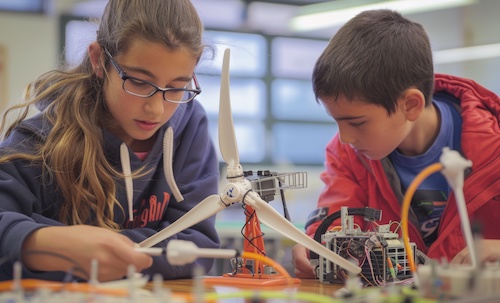Engage Students in STEM
Creating engaging STEM learning experiences in middle school is essential to spark curiosity, build foundational skills, and foster a love for STEM topics–and potentially encourage students to pursue STEM careers. Engage Students in STEM.
Here are five strategies teachers can take to make STEM come alive in their classrooms.
1. Incorporate hands-on activities and experiments
Hands-on activities let students engage directly with STEM concepts, making learning tangible and memorable. Plus, when they make mistakes, they’re motivated to try new approaches to test theories. Teachers can lead activities that allow students to see concepts in action, including simple experiments with household materials to demonstrate principles like gravity, friction, or chemical reactions. In a unit on electricity, students can create simple circuits with batteries, wires, and bulbs. For math, measurement and geometry activities like building models or plotting data can turn abstract numbers into something students can visualize and manipulate.
Teachers can encourage students to make predictions, hypothesize outcomes, and document results. This process reinforces scientific inquiry and builds critical thinking skills as students see, touch, and analyze real results from their experiments.
2. Use project-based learning for real-world problem solving
Project-based learning (PBL) prompts students to learn by engaging in real-world and meaningful projects. In STEM learning, PBL is an impactful way to show students how the concepts they learn apply outside the classroom. For instance, in an engineering-focused project, students could design a bridge model to support a specific weight, design roller coasters, or create an eco-friendly building model using sustainable materials.
When students work on projects that tackle real-world problems, they feel a sense of purpose in their work, fulfilling many students’ desire to pursue careers in which they help people. PBL also encourages collaboration and communication, as many projects are best completed in teams. Teachers can introduce community-based projects like designing solutions to environmental issues in their neighborhood, which not only reinforce STEM concepts but also show students the impact they can have. They also can ask students to compile a list of neighborhood, community, or state challenges they’d like to solve, have students break into groups, and tackle those challenges.
3. Introduce edtech tools to enhance learning
Integrating edtech tools is an effective way to capture (and keep) students’ attention and enhance learning. Apps and programs make it easy for students to explore STEM subjects interactively–for instance, coding platforms like Scratch or Tynker introduce students to programming through fun, age-appropriate challenges. Virtual labs and simulations allow students to conduct experiments that might be difficult or unsafe to perform in a classroom. These virtual simulations also are often linked to real-world problems, giving relevance to classroom lessons.
If available in a school makerspace, 3D printers are great for engaging students because they allow students to design, create, and engineer solutions, turning digital designs into physical objects they can see and touch. Teachers can guide students in designing their own models related to class lessons, from creating geometric shapes in math to building replicas of simple molecules in chemistry. Many students have used 3D printers to solve real-world problems, such as printing affordable and accessible prosthetics for those in need.
4. Encourage cross-disciplinary connections
STEM education doesn’t exist in a vacuum–many real-world applications overlap with other subjects. Cross-disciplinary connections can help students see STEM from new perspectives and understand its relevance. For example, while studying engineering principles, teachers can incorporate art by challenging students to design aesthetically-pleasing yet functional structures, blending engineering and design thinking.
STEM storytelling combines language arts with STEM, enhancing students’ understanding of scientific impact through a historical or personal lens. Even incorporating history, such as the evolution of technology or major scientific breakthroughs, can contextualize STEM subjects in ways that feel relatable and meaningful.
5. Build a culture of curiosity and encourage questioning
An environment that encourages curiosity and allows students to ask questions and explore concepts they’re genuinely interested in can significantly enhance engagement. Teachers can foster curiosity by setting up an “I Wonder” board where students post questions or topics they’d like to explore. Teachers can then incorporate these topics into the curriculum or design small projects based on students’ inquiries.
Allowing students to vote on projects or learning topics can boost engagement. For instance, in a life sciences class, rather than assigning a specific topic, allow students to research and present findings on a plant or animal of their choice. This gives them ownership of their learning and the freedom to follow their natural interests within the curriculum’s framework.
As students progress through middle school, STEM learning should focus on building curiosity, confidence, and foundational skills that students will carry with them through high school and beyond.
By incorporating hands-on activities, real-world problem-solving, edtech tools, interdisciplinary learning, and a culture of curiosity, teachers can create a dynamic and engaging learning environment. These strategies don’t just teach STEM–they empower students, showing them how they can use STEM to understand and shape the world around them. When students see how STEM relates to their lives and interests, they’re far more likely to feel motivated and excited to learn.
Source:https://www.eschoolnews.com/steam/2024/12/02/engage-middle-school-students-stem-learning/
https://www.techedmagazine.com/category/news-by-industry/stem/

